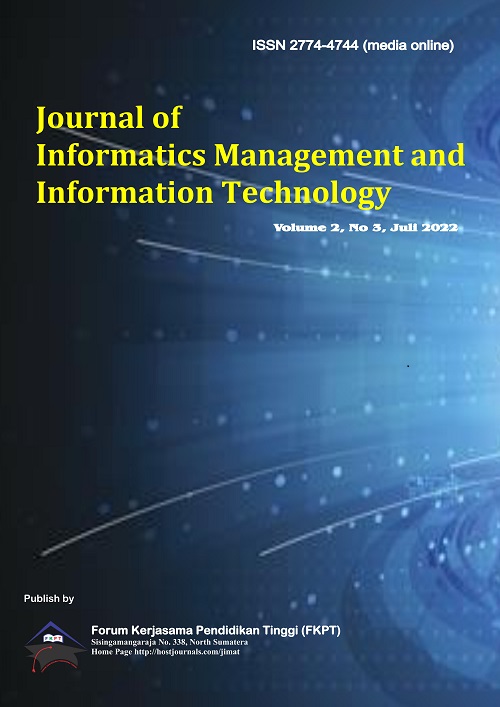Analisa Kualitas Aplikasi Performance Simanis dengan Metode End User Computing Satisfaction (EUCS)
DOI:
https://doi.org/10.47065/jimat.v2i3.169Keywords:
EUCS; IPA; Application Performance; Application Quality; AnalyticAbstract
A process to find and find out the extent of an information system implementation activity from the point of view of an information system evaluation. It aims to determine the level of user satisfaction in using a system. This study was conducted to measure the quality of the Simanis application using the End User Computing Satisfaction (EUCS) method, as well as using questionnaires to respondents and IPA Importance Performance Analysis. The results of the application quality level still need to be evaluated because the GAP level of 5 dimensions, namely content (content), accuracy (accuracy), appearance (format), user satisfaction (easy to use), and timeliness (timeliness) is still far from user expectations. The results of the user assessment of the Simanis performance application, no attributes found in quadrant 1. This indicates that the priority level for changes in some features does not exist, meaning that the features already provide the needs of the users. Suggestions in this study, application developers must continue to meet the performance expectations of the Simanis application in the 5 dimensions that have been assessed.
Downloads
References
M. A. Sugandi and R. M. N. Halim, “Analisis End-User Computing Satisfaction (Eucs) Pada Aplikasi Mobile Universitas Bina Darma,” Sistemasi, vol. 9, no. 1, p. 143, 2020, doi: 10.32520/stmsi.v9i1.625.
A. Saputra and D. Kurniadi, “Analisis Kepuasan Pengguna Sistem Informasi E-Campus Di Iain Bukittinggi Menggunakan Metode Eucs,” Voteteknika (Vocational Tek. Elektron. dan Inform., vol. 7, no. 3, p. 58, 2019, doi: 10.24036/voteteknika.v7i3.105157.
A. G. Zakinah, A. E. Prasetiyanto, and ..., “Analisis Penerimaan Sistem Informasi Dapodik Menggunakan Metode Webqual dan EUCS,” Pros. …, 2021, [Online]. Available: https://proceeding.unpkediri.ac.id/index.php/inotek/article/view/901
A. R. Darwi and E. Efrizon, “Analisis Kepuasan Pengguna E-Learning Sebagai Pendukung Aktivitas Pembelajaran Menggunakan Metode Eucs,” Voteteknika (Vocational Tek. Elektron. dan Inform., vol. 7, no. 1, p. 25, 2019, doi: 10.24036/voteteknika.v7i1.103639.
A. Dwike Ayu Rinjani and D. Rahman Prehanto, “Analisis Kepuasan Pengguna Aplikasi Bibit Reksadana Menggunakan Metode Eucs Dan Ipa,” J. Ilm. Tek. Inform. dan Sist. Inf., 2021.
I. Kurniasih and D. Pibriana, “Pengaruh Kepuasan Pengguna Aplikasi Belanja Online Berbasis Mobile Menggunakan Metode EUCS,” JATISI (Jurnal Tek. Inform. dan Sist. Informasi), vol. 8, no. 1, pp. 181–198, 2021, doi: 10.35957/jatisi.v8i1.787.
F. S. Bawardi, A. Rachmadi, and N. H. Wardani, “Analisis Kepuasan Pengguna Aplikasi Driver Ojek Online Menggunakan Metode End User Computing Satisfaction (EUCS),” J. Pengemb. Teknol. Inf. dan Ilmu Komput., vol. 3, no. 8, pp. 7694–7700, 2019.
K. Pada, K. Pusat, K. Mata, and I. E. Dan, “TRANS,” vol. 2, no. 1, pp. 58–67, 2019, doi: 10.24815/jarsp.vlil.
Y. Nurdiansyah, E. P. A. Wulandari, and D. A. R. Wulandari, “Analisis Faktor Kepuasan Pengguna Layanan Website SKCK Online Menggunakan Metode End User Computing Satisfaction (EUCS),” INFORMAL Informatics J., vol. 5, no. 2, p. 72, 2020, doi: 10.19184/isj.v5i2.18669.
J. R. Informasi, W. Astuti, R. Waluyo, S. Informasi, F. I. Komputer, and U. A. Purwokerto, “Analisis kepuasan mahasiswa terhadap aplikasi pedulilindungi menggunakan metode eucs,” vol. 11, no. 1, pp. 9–16, 2022.
M. A. Yazid, S. H. Wijoyo, and R. I. Rokhmawati, “Evaluasi Kualitas Aplikasi Ruangguru Terhadap Kepuasan Pengguna Menggunakan Metode EUCS (End-User Computing Satisfaction) dan IPA (Importance Performance Analysis),” J. Pengemb. Teknol. Inf. dan Ilmu Komput., vol. 3, no. 9, pp. 8496–8505, 2019.
F. R. Wilujeng, G. D. Rembulan, D. Andreas, and H. Tannady, “Meningkatkan Kepuasan Pelanggan pada Dua Bisnis E-Commerce Terbesar di Indonesia dengan Menggunakan Analisis Servqual dan IPA,” Pros. Semin. Nas. Sains dan Teknol., pp. 1–9, 2019.
J. Saputra et al., “Analisis Kualitas Website Institut XYZ Menggunakan Metode Webqual dan IPA,” J. Sains Komput. Inform. (J-SAKTI, vol. 5, no. 1, p. 318, 2021.
E. Sutinah and O. R. Simamora, “Metode Fuzzy Servqual Dalam Mengukur Kepuasan Pasien Terhadap Kualitas Layanan BPJS Kesehatan,” J. Inform., vol. 5, no. 1, pp. 90–101, 2018, doi: 10.31311/ji.v5i1.2944.
M. Ariska, M. Fahru, and J. W. Kusuma, “Leverage , Ukuran Perusahaan dan Profitabilitas dan Pengaruhnya Terhadap Tax Avoidance pada Perusahaan Sektor Pertambangan di Bursa Efek Indonesia Tahun 2014-2019,” J. Revenue J. Ilm. Akunt., vol. 01, no. 01, pp. 133–142, 2020.
H. Setiawan and D. Novita, “Analisis Kepuasan Pengguna Aplikasi KAI Access Sebagai Media Pemesanan Tiket Kereta Api Menggunakan Metode EUCS,” J. Teknol. Sist. Inf., vol. 2, no. 2, pp. 162–175, 2021, doi: 10.35957/jtsi.v2i2.1375.
P. P. Sentosa, N. M. E. O. Astuti, and I. M. E. Cahaya, “Analisis Kepuasan Mahasiswa Menggunakan Metode Servqual,” Media Edukasi, vol. 3, no. 2, pp. 85–96, 2019.
2021 Hasna & Nuryana, “Analisis Kualitas Layanan Website Sociolla terhadap Kepuasan Pelanggan dengan Metode WebQual 4.0 dan Importance Performance Analysis (IPA),” Jeisbi, vol. 02, no. 04, p. 2021, 2021.
Bila bermanfaat silahkan share artikel ini
Berikan Komentar Anda terhadap artikel Analisa Kualitas Aplikasi Performance Simanis dengan Metode End User Computing Satisfaction (EUCS)
ARTICLE HISTORY
Issue
Section
Copyright (c) 2022 Meidita Nurul Farisi, Eva Zuraidah

This work is licensed under a Creative Commons Attribution 4.0 International License.
Authors who publish with this journal agree to the following terms:
- Authors retain copyright and grant the journal right of first publication with the work simultaneously licensed under Creative Commons Attribution 4.0 International License that allows others to share the work with an acknowledgment of the work's authorship and initial publication in this journal.
- Authors are able to enter into separate, additional contractual arrangements for the non-exclusive distribution of the journal's published version of the work (e.g., post it to an institutional repository or publish it in a book), with an acknowledgment of its initial publication in this journal.
- Authors are permitted and encouraged to post their work online (e.g., in institutional repositories or on their website) prior to and during the submission process, as it can lead to productive exchanges, as well as earlier and greater citation of published work (Refer to The Effect of Open Access).















